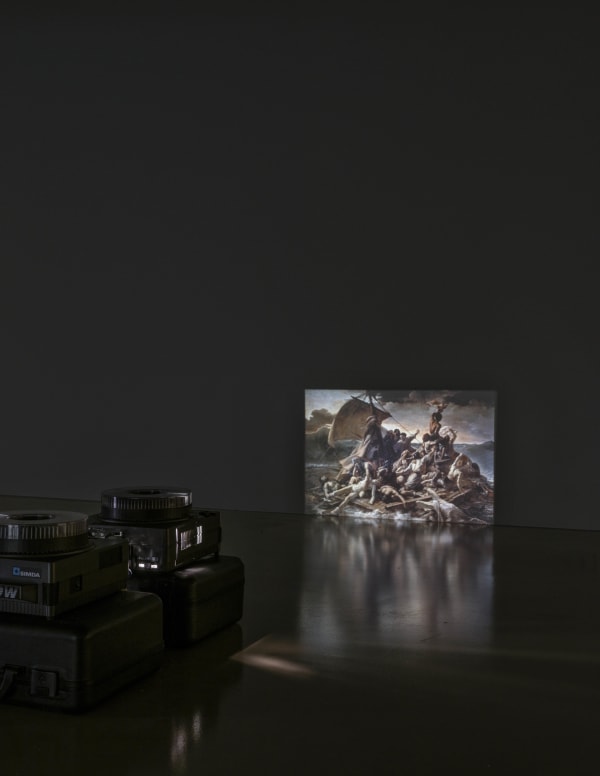Germaine Kruip: After Image
Gallery Baton is pleased to present Germaine Kruip’s solo exhibition After Image from February 22ndto March 23rd. This exhibition has been curated by Krist Gruijthuijsen, the director of KW Institute for Contemporary Art, Berlin.
Over the past two decades, Dutch artist Germaine Kruip (b. 1970) has steadily developed a practice, which merges time, space and perception. With a background in stage direction, she investigates, simplifies and presents her observations in a subtle manner often through architectural interventions. In each of these interventions, she changes a location into a stage, with the audience as actors in a play of substantive absence. By doing so, she activates both physical and mental awareness.
In her first exhibition at Gallery Baton, Kruip combines earlier works with more recent ones in order to continue her investigation into simultaneity by which both the physical as well as mental space is being challenged. The notion of simultaneity is underlined by the mechanism of what is considered to be ‘real’ or ‘reality’. The registration and illustration of our surroundings, both naturally as well as artificially, form the backbone for interventions that often appear minimal and stark. Two Seconds (2000), the earliest piece in the show presented in the Blue Baton space, dissects the apparatus of theatre and cinema by placing a museum-like bench in front of the large window. By placing the visitor on display, Kruip creates a space of confrontation while simultaneously allowing space to overlook the streets from inside the gallery. The sound coming from the street is transmitted live into the gallery with a two-second delay, therefore disrupting the familiarity of the daily scenes being observed. At intervals, an assistant of the gallery joins the visitor and shares an intimate scripted thought. I See a Landscape (2004-2019) is a monologue taken from a script by Jean-Luc Godard questioning, in a poetic sense, what is being observed and what is considered to be reality.
In the main gallery, the visitor is confronted by a large projection on the back wall, reminiscent of a stage or cinema screen. After Image (2019) stems from a larger research titled A Possibility of an Abstraction (2014-), where the artist transforms the theatrical space into a cinematic experience. It is a play of perception in which shadow, reflection, architecture, and stage become characters in a film-like experience constituted within the moment itself. Similar to the pre-cinematic traditions of puppetry and shadow play, Kruip creates an atmospheric, film-like effect without actually using film, manipulating light across a proscenium stage that serves as a stand-in for the screen. Shifting between the cinematic and the sculptural, A Possibility of an Abstraction creates a meditative space at the edges of our perception with optical illusions and passages of time. For Gallery Baton, Kruip has taken a scene from the theatre piece and translates it into the gallery space, in which a projected rectangle shape reminds the viewer of a filmic experience as the slow shift from positive to negative resembles the process of photography and documenting. The duration of this shift is interrelated to the gallery lights located in Blue Baton which formed the work Rehearsal (2002-2019) turns the gallery into a theatre space with the gallery lights slowly go on and off.
The perception of reality and its documentation (i.e. the apparatus of photography) is clearly illustrated in Image Archive (2004-), which is an ongoing collection of images compiled over the past 15 years. Two synchronised projectors feature 35mm slides presenting photojournalistic and art historical imagery found in newspapers. While their appearance in newspapers suggests objective representation, the fact that similar images re-appear again in other contexts casts doubt on this supposed objectivity.
This exploration into simultaneity and repetition is juxtaposed with an instrument that appears at first mass-produced but due to its tone reveals its uniqueness. Since 2017, Kruip has been collaborating with instrument manufacturer Thein Brass in Germany, known for experimenting with avant-garde composers. The artist first reinterpreted the shape of a brass percussion triangle into a rhombus and a circle, therefore re-envisioning its shape, sound and function. Both pieces have a width of one cm and a total circumference of one meter. For Double Brass Line (Thein No. 183114) (2018), the artist continues to work with the length of one meter by realising two brass rods that are presented next to each other, floating on the wall mid-height. Played repeatedly, the two rods of Double Brass Line create a powerful overtone, produced by their proximity and amplified by their position to the wall. These unique tones that are being produced could be viewed as the overall score of the exhibition.
In a reduced sense, After Image questions notions of authenticity and similarity through various vantage points and therefore underlines Kruip’s ongoing interest in the position of the spectator and production and understanding of imagery.
Germaine Kruip has held solo exhibitions at Kunsthalle Fridericianum, Kassel (2003); Stedelijk Museum Bureau Amsterdam, Amsterdam (2002); and De Vleeshal, Middleburg (2006). She has participated in group exhibitions such as Kunsthalle Münster, Münster (2012); and S.M.A.K(Stedelijk Museum voor Actuele Kunst), Gent (2008). She has presented a wide range of genres from sculpture to performance at international venues such as KW Institute for Contemporary Art, Berlin (2017); the 20th Biennale of Sydney (2016), Sydney; Art Basel, Basel (2012, 2008); and Frieze, London (2005). She was educated at DasArts, Amsterdam and Rijksakademie van Beeldende Kunsten, Amsterdam. She lives and works in Amsterdam and Brussels.






